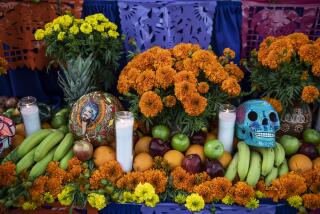Human Sacrifices : Halloween Was Deadly Serious for Old Celts
- Share via
KANSAS CITY — The ancient Celts took Halloween so seriously it’s scary, says Sharron Uhler, historical researcher at Hallmark Cards Inc.
The Celts believed that each year on Nov. 1 the dead returned to mingle with the living. Ceremonies of All Hallow’s Eve date back to 700 BC and the Druids of Wales, Ireland and Scotland.
Historical explanations of the origin of trick-or-treating differ, according to Uhler, but two customs may have led the way.
“One possibility involved the Druids’ practice of offering gifts to their gods in return for heavenly rewards,” she says.
“These ‘treats’ included black cats and human beings, who were imprisoned in wicker cages and sacrificed in fires.”
Cheerier Theory
More cheerful is the theory that Druids offered banquets on the Druid’s New Year’s Eve, Oct. 31, for the ghosts and spirits haunting their homes. After ‘treating’ the ghosts, villagers--acting like souls of the dead and dressed in costumes and masks--”tricked” the spirits into following them out of town and away from their homes.
Halloween has been marked in the United States for less than 150 years. The custom came with Irish Catholics who emigrated to the United States to escape the potato famine of the late 1840s.
One legend has the custom of jack-o’-lanterns at Halloween originating with an Irish alcoholic named Jack O’Grady. According to the legend, O’Grady was turned away from heaven because of his drunken ways. When he tried to trick the devil, he was banished even from hell. So he wanders the Earth with a pumpkin lantern, visible only on Halloween.
Historians claim that evil witches on broomsticks didn’t crash into Halloween lore until the Middle Ages. Before that, witches were as likely to be good as villainous.
More to Read
Inside the business of entertainment
The Wide Shot brings you news, analysis and insights on everything from streaming wars to production — and what it all means for the future.
You may occasionally receive promotional content from the Los Angeles Times.










